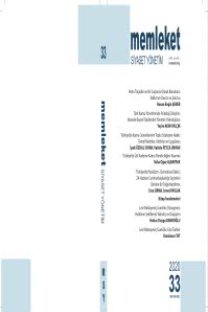MISIR MODERNLEŞMESİNİN TARİHSEL KÖKENLERİ: MEHMET ALİ PAŞA DÖNEMİ ÜZERİNE BİR İNCELEME
THE HISTORICAL ROOTS OF EGYPTIAN MODERNIZATION: AN ANALYSIS ON THE MEHMED ALİ PASHA ERA
___
- Abul-Magd, Zeinab, The Egyptian Military in Politics and the Economy: Recent History and Current Transition Status, CMI Insight, Sayı: 2, 2013, s. 1-5.
- Aharoni, Reuven, The Pashas Bedouin: Tribes and State in the Egypt of Mehemet Ali, 1805-1848, London: Routledge, 2007.
- Baer, Gabriel, A History of Landownership in Modern Egypt, 1800- 1950, London, Oxford University Press, 1962.
- Beinin, Joel, Workers and Peasants in the Modern Middle East, Cambridge, Cambridge University Press, 2001.
- Bellin, Eva, Robutness of Authoritarianism in the Middle East: Exceptionalism in Comparative Perspective, Comparative Politics, Cilt: 36, Sayı: 2, 2004, s. 139-157.
- Cole, Juan R. I., Colonialism and Revolution in the Middle East: Social and Cultural Origins of Egypts Urabi Movement, Cairo, The American University in Cairo Press, 1999.
- Dodwell, Henry, The Founder of Modern Egypt, Cambridge, Cambridge University Press, 1931.
- Dunn, John, Egypts Nineteenth-Century Armaments Industry, The Journal of Military History, Cilt: 61, Sayı: 2, 1997, s. 231-254.
- Dunn, John, Khedive Ismails Army, New York, Routledge, 2005. Fahmy, Khaled, The Era of Muhammad Ali Pasha, (Ed. M. W.
- Dally), The Cambridge History of Egypt, Vol. 2: Modern Egypt, from 1517 to the End of the Twentieth Century, Cambridge, Cambridge University Press, 1998, s. 139-180.
- Fahmy, Khaled, The Nation and its Deserters: Conscription in Mehmed Alis Egypt, International Review of Social History, Cilt: 43, Sayı: 3, 1998, s. 421-436.
- Fahmy, Khaled, Kavalalı Mehmet Ali Paşanın Nizam-ı Cedid Ordusunda Çıkan İsyan, (Ed. Jane Hathaway), Osmanlı İmparatorluğunda İsyan ve Ayaklanma, İstanbul, Alkım, 2007, s. 201-215.
- Fahmy, Khaled, Mehmed Ali: From Ottoman Governor to Ruler of Egypt, Oxford, Oneworld, 2009.
- Fahmy, Khaled, Paşanın Adamları: Kavalalı Mehmed Ali Paşa, Ordu ve Modern Mısır, (Çev. Deniz Zarakolu), İstanbul, İstanbul Bilgi Üniversitesi Yayınları, 2010.
- Genç, Mehmet, İltizam, İslam Ansiklopedisi, C. 22, İstanbul, Türkiye Diyanet Vakfı, 2000, s. 154-158.
- Hathaway, Jane, The Military Household in Ottoman Egypt, International Journal of Middle East Studies, Cilt: 27, Sayı: 1, 1995, s. 39-52.
- Heyworth-Dunne, J., History of Education in Modern Egypt, London, Luzac&Co., 1938.
- Hinnebusch, Raymond A., Authoritarian Persistence, Democratization Theory, and the Middle East: An Overview and Critique, Democratization, Cilt: 13, Sayı: 3, 2006, s. 373-395.
- Hourani, Albert, Osmanlı Reformu ve Eşraf Politikaları, (Ed. William R. Polk ve Richard L. Chambers), Ortadoğuda Modernleşme, İstanbul, İnsan Yayınları, 1995, s. 61-101.
- Hunter, F. Robert, Egypt Under the Khedives, 1805-1879: from Household Government to Modern Bureaucracy, Cairo, The American University of Cairo Press, 1999.
- Hunter, F. Robert, State-Society Relations in Nineteenth-Century Egypt: The Years of Transition, Middle Eastern Studies, Cilt: 36, Sayı: 3, 2000, s. 145-159.
- Issawi, Charles, Egypt at Mid-Century: An Economic Survey, Oxford, Oxford University Press, 1954.
- Issawi, Charles, Egypt Since 1800: A Study in Lop-Sided Development, The Journal of Economic History, Cilt: 21, Sayı: 1, 1961, s. 2-25.
- Issawi, Charles, Egypt in Revolution: An Economic Analysis, Oxford, Oxford University Press, 1963.
- Issawi, Charles, De-Industralization and Re-Industralization in the Middle East since 1800, International Journal of Middle East Studies, Cilt: 12, Sayı: 4, 1980, s. 469-479.
- Kutluoğlu, Muhammed H., The Egyptian Question (1831-1841), İstanbul, Eren Yayıncılık 1998.
- Lababidi, Lesley, Muhammad Ali and Modernization, (Ed. Aleya Serour), Writing Egypt: History, Literature, and Culture, Cairo, The American University in Cairo, 2012, s. 83-93.
- Lacouture, Jean ve Simonne Lacouture, Egypt in Transition, London, Methuen&Co. Ltd., 1958.
- Lapidus, Ira M., İslam Toplumları Tarihi, Cilt. I: Hazreti Muhammedden 19. Yüzyıla, (Çev.Yasin Aktay), İstanbul, İletişim, 2002.
- Marsot, Afaf Lutfi al-Sayyid, Egypt in the Reign of Muhammad Ali, Cambridge, Cambridge University Press, 1984.
- Marsot, Afaf Lutfi al-Sayyid, Mısır Tarihi: Arapların Fethinden Bugüne, (Çev. Gül Çağalı Güven), İstanbul, Tarih Vakfı Yurt Yayınları, 2010.
- Mitchell, Timothy, Mısırın Sömürgeleştirilmesi, (Çev. Zeynep Altok), İstanbul İletişim Yayınları, 2001.
- Owen, Roger, Cotton and Egyptian Economy, Oxford, Oxford University Press, 1969.
- Pamuk, Şevket, 100 Soruda Osmanlı-Türkiye İktisadi Tarihi: 1500- 1914, İstanbul, Gerçek Yayınevi, 1999.
- Özkaya-Özer, Sevda, Osmanlı İdaresinde Mısır (1839-1882), (Yayımlanmamış Doktora Tezi), Elazığ: Fırat Üniversitesi, Sosyal Bilimler Enstitüsü, 2007.
- Salzman, Philip, The Middle Easts Tribal DNA, Middle East Quarterly, Cilt: 15, Sayı: 1, 2008, s. 23-33.
- Sharabi, Hisham, Neopatriarchy: A Theory of Distorted Change in Arab Society, New York, Oxford University Press, 1988.
- Silvera, Alain, The First Egyptian Student Mission to France under Muhammad Ali, (Ed. Elie Kedourie ve Sylvia G. Haim), Modern Egypt: Studies in Politics and Society, London, Frank Cass and Company Limited., 1980, 1-23.
- Sinouê, Gilbert, Kavalalı Mehmet Ali Paşa: Son Firavun, (Çev. Ali Cevat Akkoyunlu), İstanbul Doğan Kitap, 2004.
- Toledano, Ehud R., State and Society in Mid-Nineteenth-Century Egypt, Cambridge, Cambridge University Press, 1990.
- Toledano, Ehud R., Social and Economic Change in the Long Nineteenth Century, (Ed. M. W. Daly), The Cambridge History of Modern Egypt, Vol. 2: Modern Egypt, From 1517 to the end of the Twentieth Century, Cambridge, Cambridge University Press, 2008, s. 252-285.
- Vatikiotis, P. J., The Modern History of Egypt, London, Weidenfeld and Nicolson, 1969.
- Verdery, Richard N. The Publications of the Bulaq Press under Muhammad Ali of Egypt, Journal of American Oriental Society, Cilt: 91, Sayı: 1, 1971, s. 129-132.
- Weinryb, Bernard D., Industrial Development of the Near East, The Quarterly Journal of Economics, Cilt: 61, Sayı: 3, 1947, s. 471- 499.
- Yazıcı, Nesimi, Vakayi-i Mısriyye Üzerine Birkaç Söz, Ankara Üniversitesi Osmanlı Tarihi Araştırma ve Uygulama Merkezi Dergisi, Sayı: 2, 1990, s. 267-278.
- ISSN: 1306-8202
- Yayın Aralığı: 2
- Başlangıç: 2006
- Yayıncı: Yerel Yönetim Araştırma Yardım ve Eğitim Derneği (YAYED)
RES PRIVATE-RES PUBLICA İLİŞKİSİ ÜZERİNDEN CUMHURİYETÇİ DÜŞÜNCENİN EVRİMİ
YOAV PELED'İN ETNO-CUMHURİYETÇİLİK KAVRAMI ÜZERİNE
GÜZEL SANATLARIN BİR DALI OLARAK DEVLET
MISIR MODERNLEŞMESİNİN TARİHSEL KÖKENLERİ: MEHMET ALİ PAŞA DÖNEMİ ÜZERİNE BİR İNCELEME
YOAV PELED'İN ETNO-CUMHURİYETÇİLİK KAVRAMI ÜZERİNE
MECLİS TUTANAKLARI ÜZERİNDEN 1924 TEŞKİLAT-I ESASİYE KANUNU TARTIŞMALARI
